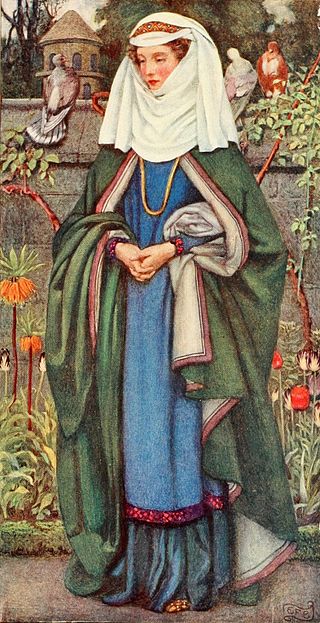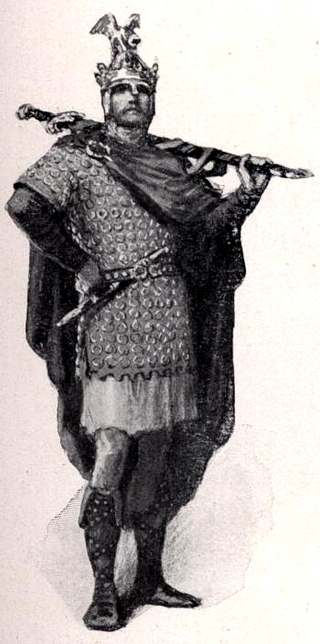
King Arthur, according to legends, was a king of Britain. He is a folk hero and a central figure in the medieval literary tradition known as the Matter of Britain.
Geraint, known in Latin as Gerontius, was a king of Dumnonia who ruled in the early 8th century. During his reign, it is believed that Dumnonia came repeatedly into conflict with the neighbouring Anglo-Saxon kingdom of Wessex. Geraint was the last recorded king of a unified Dumnonia, and was called King of the Welsh by the Anglo-Saxon Chronicle. Subsequent kings of Dumnonia reigned over an area that was eventually reduced to the limits of present-day Cornwall.

The Knights of the Round Table are the legendary knights of the fellowship of King Arthur that first appeared in the Matter of Britain literature in the mid-12th century. The Knights are an order dedicated to ensuring the peace of Arthur's kingdom following an early warring period, entrusted in later years to undergo a mystical quest for the Holy Grail. The Round Table at which they meet is a symbol of the equality of its members, who range from sovereign royals to minor nobles.

Percival, alternatively called Peredur, is a figure in the legend of King Arthur, often appearing as one of the Knights of the Round Table. First mentioned by the French author Chrétien de Troyes in the tale Perceval, the Story of the Grail, he is best known for being the original hero in the quest for the Grail before being replaced in later literature by Galahad.

Welsh mythology consists of both folk traditions developed in Wales, and traditions developed by the Celtic Britons elsewhere before the end of the first millennium. As in most of the predominantly oral societies Celtic mythology and history were recorded orally by specialists such as druids. This oral record has been lost or altered as a result of outside contact and invasion over the years. Much of this altered mythology and history is preserved in medieval Welsh manuscripts, which include the Red Book of Hergest, the White Book of Rhydderch, the Book of Aneirin and the Book of Taliesin. Other works connected to Welsh mythology include the ninth-century Latin historical compilation Historia Brittonum and Geoffrey of Monmouth's twelfth-century Latin chronicle Historia Regum Britanniae, as well as later folklore, such as the materials collected in The Welsh Fairy Book by William Jenkyn Thomas (1908).
Constantine was a 6th-century king of Dumnonia in sub-Roman Britain, who was remembered in later British tradition as a legendary King of Britain. The only contemporary information about him comes from Gildas, who castigated him for various sins, including the murder of two "royal youths" inside a church. The historical Constantine is also known from the genealogies of the Dumnonian kings, and possibly inspired the tradition of Saint Constantine, a king-turned-monk venerated in southwest Britain and elsewhere.

The historicity of King Arthur has been debated both by academics and popular writers. While there have been many claims that King Arthur was a real historical person, the current consensus among specialists on the period holds him to be a mythological or folkloric figure.
Cador is a legendary Duke of Cornwall, known chiefly through Geoffrey of Monmouth's pseudohistorical Historia Regum Britanniae and previous manuscript sources such as the Life of Carantoc. In Welsh genealogical records, he appears as Cado, the son of Cornish king Geraint. Early sources present him as a relative of King Arthur, though the details of their kinship are usually left unspecified.

In Arthurian legend, Ywain, also known as Yvain and Owain among other spellings, is a Knight of the Round Table. Tradition often portrays him as the son of King Urien of Gorre and of either the enchantress Modron or the sorceress Morgan le Fay. The historical Owain mab Urien, the basis of the literary character, ruled as the king of Rheged in Britain during the late-6th century.

Erec and Enide is the first of Chrétien de Troyes' five romance poems, completed around 1170. It is one of three completed works by the author. Erec and Enide tells the story of the marriage of the titular characters, as well as the journey they go on to restore Erec's reputation as a knight after he remains inactive for too long. Consisting of about 7000 lines of Old French, the poem is one of the earliest known Arthurian romances in any language, predated only by the Welsh prose narrative Culhwch and Olwen.
The Three Welsh Romances are three Middle Welsh tales associated with the Mabinogion. They are versions of Arthurian tales that also appear in the work of Chrétien de Troyes. Critics have debated whether the Welsh Romances are based on Chrétien's poems or if they derive from a shared original. The Romances survive in the White Book of Rhydderch and the Red Book of Hergest, both from the 14th century, though the material is at least as old as Chrétien.
Geraint son of Erbin is a medieval Welsh poem celebrating the hero Geraint and his deeds at the Battle of Llongborth. The poem consists of three-line englyn stanzas and exists in several versions all in Middle Welsh. The earliest surviving version is in the Black Book of Carmarthen, completed around 1250, though the poem may have been composed in the 10th or 11th century. The poem is significant for its early mention of King Arthur.

Enide is a character in Arthurian romance. She is married to Erec in Chrétien de Troyes' Erec and Enide, and to Geraint in the Welsh romance of Geraint and Enid analogous to Chrétien's version. Some scholars believe the French and Welsh tales derive from a lost common source, but it seems more likely Geraint derives directly or indirectly from Erec, though Chrétien may have had a Welsh or Breton source.

In Arthurian legend, Gringolet is Sir Gawain's powerful war horse.
Erbin of Dumnonia was a 5th-century King of Dumnonia and saint of Wales.

King Arthur's family grew throughout the centuries with King Arthur's legend. The earliest Welsh Arthurian tradition portrays Arthur as having an extensive family network, including his parents Uther Pendragon and Eigyr (Igraine), wife Gwenhwyfar (Guinevere), nephew Gwalchmei (Gawain), brother, and several sons; his maternal lineage is also detailed, linking him to relatives like his grandfather. This complex familial structure is simplified in the shared British and greater European tradition of chronicles and medieval romances influenced by Geoffrey of Monmouth's writings, which instead introduce new characters like Arthur's half-sisters including Morgan and Morgause, theirs children including Yvain and Mordred, and others. Arthur's lineage was later claimed by various rulers, especially the House of Tudor and Scottish clans, reflecting the enduring legacy of his familial ties in medieval and early modern genealogies.

Edern ap Nudd was a knight of the Round Table in Arthur's court in early Arthurian tradition. As the son of Nudd, he is the brother of Gwyn, Creiddylad, and Owain ap Nudd. In French romances, he is sometimes made the king of a separate realm. As St Edern, he has two churches dedicated to him in Wales.

The Battle of Hingston Down took place in 838, probably at Hingston Down in Cornwall between a combined force of Cornish and Vikings on the one side, and West Saxons led by Ecgberht, King of Wessex on the other. The result was a West Saxon victory. According to the Anglo-Saxon Chronicle, which called the Cornish the West Welsh:













